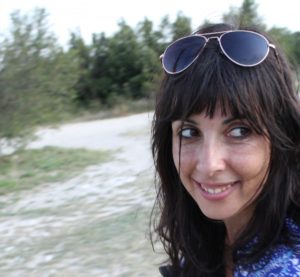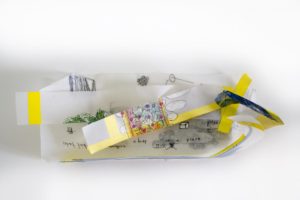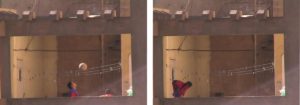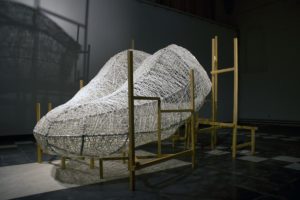SARETTA MORGAN interviews YOUMNA CHLALA

Youmna Chlala was born in Beirut and is currently based in New York City. Her work investigates the relationship between fate and architecture through video, drawing, books, installation, and performance. She was recently an Open Sessions artist at The Drawing Center and a resident artist at the Lower Manhattan Cultural Center’s Process Space. Her work has been widely exhibited at spaces that include Art Dubai Projects; Institute of Contemporary Arts, London; Rotterdam International Film Festival; Camera Austria; Art in General, New York; and San Jose Museum of Art. Her writing has appeared in numerous journals. Chlala is the Founding Editor of Eleven Eleven {1111} Journal of Literature and Art and recipient of a Joseph Henry Jackson Award. Her poetry book, The Paper Camera, will be published by Litmus Press in 2017.
Saretta Morgan met with Chlala at McNally Jackson Books in SoHo, New York City, in the late spring of 2016 to talk about relationships, speculation and space.
*
Saretta Morgan (SM): I want to start by talking about the work you exhibited at The Drawing Center last year, It’s Not Easy to See the Grass in Things and in Words (2015). When I saw the show I nicknamed your pieces “dream houses.” While standing in front of them they felt like homes to me. But before meeting with you today I looked at the images again on my phone, and I realized that they aren’t house-like at all. It made me wonder what I expect a house to do. There’s some way that you’re evoking a house while also challenging my understanding of what a house can be. Could you talk about making those?

Youmna Chlala (YC): I love that you call them dream houses. I was inventing spaces of potential. Spaces that were enclosures in the sense that a house would be, but open in the sense that [they] would contain an idea or an accumulation of idea. That’s where sculpture and drawing came together for me.
As for the dream aspect, [these pieces] were very much about the future. I saw them as speculative moments. The reason I wanted to show them as a photograph and not as an installed sculpture or drawing-sculpture was because I thought that a photo would create distance for the viewer. In a way, the distancing would locate them in time. The viewer would know that at the time of the photograph [the objects] existed in that way, and a viewer could then place their own projected future onto the objects.
SM: The space of potential makes me think about the complex relationships between public and private that emerge in your work. The two concepts appear as, not necessarily fluid, but simultaneous. I’m wondering if you can talk more about that.
YC: I think public verses private goes back to what is denoted culturally so depending on where you are in the world those shift all the time.
One of my videos, Days of Being Wild (2013) is of two young boys on a balcony in Cairo, just playing soccer. It’s really about the architecture of the balcony as an in-between space that is both public and private. It’s attached to the home and it’s visible. I shot the video because I noticed myself being a voyeur to these two young boys playing—and the intimacy of playing and the freedom of play.
The video piece was shown in tiny room built with a partial wall so that someone walking in the gallery could see the legs and feet of the viewers. Since the video itself cuts at the waist, the viewer only sees the boys playing from the waist up. Everyone is a voyeur. The space was designed to mimic the balcony and the view of multiple spaces as well as the tightness, small scale, and intimacy.

SM: What do you think happens when something intimate is given more of a public circulation?
YC: I think that we don’t have enough opportunities to participate in intimacy. There’s this idea that intimacy happens inside, and outside you have a different self. And by intimacy I don’t mean displays of affection, I mean real exchange. That is at the core of a lot of my performance and video work.
SM: You work in several disciplines. Can you talk about how you came to making things, and how that process has evolved for you over time?
YC: I’m very experiential and I’ve always been enamored with intellectual pursuit, books and theory, but I’ve also been suspicious of those things since first encountering them. That suspicion has led me to make things in order to make sense of my experiences and to answer questions.
SM: You mention being suspicious of “intellectual pursuit, books and theory.” Can you say where that suspicion comes from?
YC: I think it comes from having moved to Los Angeles when I was young and feeling as though I’d been dropped in from outer space. I’d come from a very complicated, tumultuous moment geopolitically but my immediate experience as a child was full of joy and possibility.
I was placed in a world where I continued to experience things differently from the way they were being proposed. When I was old enough to have my own past historicized, contextualized, I found there was dissonance between what I had actually experienced and what I was supposed to have gone through.
SM: The “joy and possibility” you found in LA—where did that come from?
YC: I have an amazing family. My parents created a foundation where the expectation was that we would do well. Not because of any specific aspirations that they have for us but because they could see our worth.
I used to do human rights work and dignity is at the center of human rights language. I was drawn to the idea of dignity and how it might materialize, how it is embodied, what it means outside of rhetoric. In part it has to do with worth—and not calculable worth, just that everyone has a reason for being and a sense of being.
SM: Have there been times when you felt you could see that principle materialized in space?
YC: The language component of human rights seemed liberating because once you understand that people are creating language that names you then one way to subvert that process is to be at the table when the naming is happening. You identify your own needs and your community’s needs. In the same way that language is made, space is made with the needs and desires of certain people in mind.
I became interested in spatiality because I became disillusioned with language. I started studying architectural theory. It named what was missing from rights as a system—a discussion of how space affects people. And the way that space affects your sense of self and your connection to other people. Your ability to dream, think and be. The way certain spaces actively negate that possibility. So not just space as a potential but as a way to culturally and institutionally negate one’s sense of being a full self. That’s where space first entered my consciousness.
SM: What do you see as being the distance between individual bodies and their environments. How permeable is that boundary where a body, object or narrative ends and the environment begins. Is that something you think about?
YC: I think the permeations are always evolving and changing based on where you are and who you are and whom you’re with. They are a constant set of negotiations—body / object / space; body/ object / space. If the world is a field then they’re always moving in that field and reimagining boundaries.
SM: The way you’re talking about them makes me think about language. The way words play off other associations and constantly take on new meanings in context.
YC: Yes and words that attempt to name those relationships are always being reimagined. There’s something comforting in constant change. Though there are also times when one just wants to be understood without the work of translating and working through the dissonance and misunderstandings that constant evolution can produce.
My installation I Am Who You Say I Say Who You Are (2013) was about this very feeling. It was a sculptural tongue on a scaffold-like pedestal— a built stage that hosts a tongue under continual construction.

That’s also what I like about drawing. How deconstruction is part of the building process—the potential for erasure to be a mark. Instead of erasure equating negation, it’s cumulative.
SM: You mentioned accumulation earlier when you were talking about your dream houses. It’s interesting to me that you see them as sites of accumulation, can we return to that?
YC: What I like about you referring to them as houses is in part due to the gesture of the frame. Making them into photographs, which then have a border, or boundary—the frame—is essentially creating a space in which things can accumulate. The frame can contain them. So to read them as houses is supported by the way they were installed—the scale, shown as a grid, the height—it was all intentional. Which is why you felt that they were houses when you viewed them in person and not as cellphone images. The way your body related to them on the wall was different from how they existed as images in your hand.
That’s another reason for making things. Not just making them to show them but to think about how they are shown, where they are shown, and how the body can come to engage them.
*
Youmna Chlala is an interdisciplinary artist based in New York City.
*
Saretta Morgan is a text-based artist living in Brooklyn, New York.
*
Photo credits: Headshot of Youmna Chlala by Ken Chen; Image 1 is a component of the show “It’s Not Easy to See the Grass in Things or in Words” (2015); Image 2 is a video still from the installation “Days of Being Wild” (2013) at Art in General, NYC; Image 3, titled “Langue,” is a sculpture component of “I Am Who You Say I Say Who You Are” (2013).



